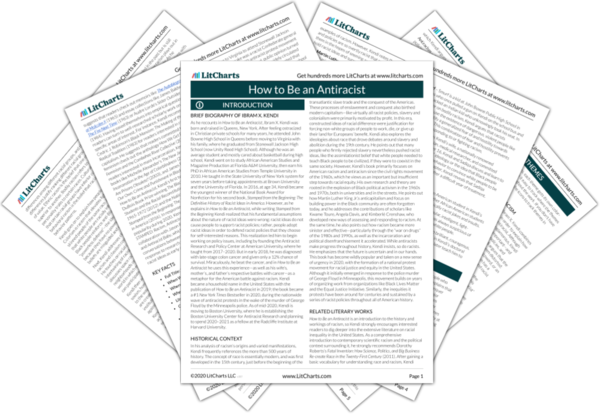Welcome to the LitCharts study guide on Ibram X. Kendi's How to Be an Antiracist. Created by the original team behind SparkNotes, LitCharts are the world's best literature guides.
How to Be an Antiracist: Introduction
How to Be an Antiracist: Plot Summary
How to Be an Antiracist: Detailed Summary & Analysis
How to Be an Antiracist: Themes
How to Be an Antiracist: Quotes
How to Be an Antiracist: Characters
How to Be an Antiracist: Terms
How to Be an Antiracist: Symbols
How to Be an Antiracist: Theme Wheel
Brief Biography of Ibram X. Kendi

Historical Context of How to Be an Antiracist
Other Books Related to How to Be an Antiracist
- Full Title: How to Be an Antiracist
- When Written: 2016–2019
- Where Written: Florida and Washington, D.C.
- When Published: August 2019
- Literary Period: Contemporary Nonfiction
- Genre: Popular Nonfiction, American History and Politics, Memoir, Self-Improvement
- Setting: Queens, New York; Manassas, Virginia; Tallahassee, Florida; Philadelphia, Pennsylvania; Oneonta, New York; Providence, Rhode Island; Washington, D.C.
- Climax: In college and his early years as a professor, Kendi realizes that racism and antiracist activism must focus specifically on changing policy, rather than education and public outreach.
- Antagonist: Racial inequity; racist power, policies, and ideas
- Point of View: First Person
Extra Credit for How to Be an Antiracist
Antiracist Renaming. In How to Be an Antiracist, Kendi recalls ambivalently moving to Virginia to attend Stonewall Jackson High School, whose namesake was a racist Confederate general in the Civil War. During the 2020 antiracist protest movement inspired by the murder of George Floyd, public opinion turned sharply towards renaming the school, and a widely circulated petition with tens of thousands of signatures suggested that the school be renamed Ibram X. Kendi High School. (The school administration was reluctant to name the school after a living person, so instead renamed it Unity Reed High School.)







